Case Study Analysis Gyro Holdings Report 2022
VerifiedAdded on 2022/10/14
|13
|3255
|11
AI Summary
Contribute Materials
Your contribution can guide someone’s learning journey. Share your
documents today.
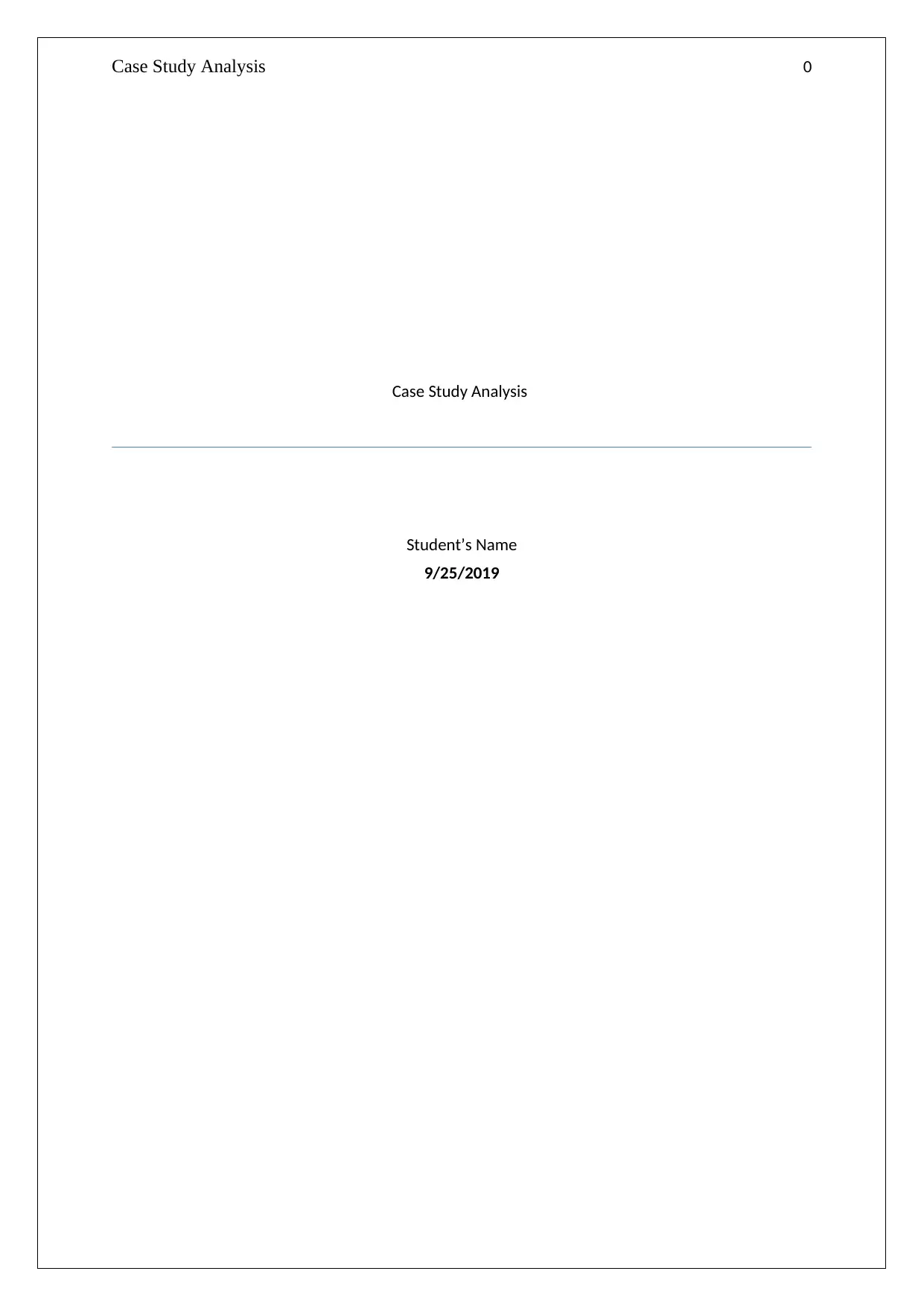
Case Study Analysis 0
Case Study Analysis
Student’s Name
9/25/2019
Case Study Analysis
Student’s Name
9/25/2019
Secure Best Marks with AI Grader
Need help grading? Try our AI Grader for instant feedback on your assignments.
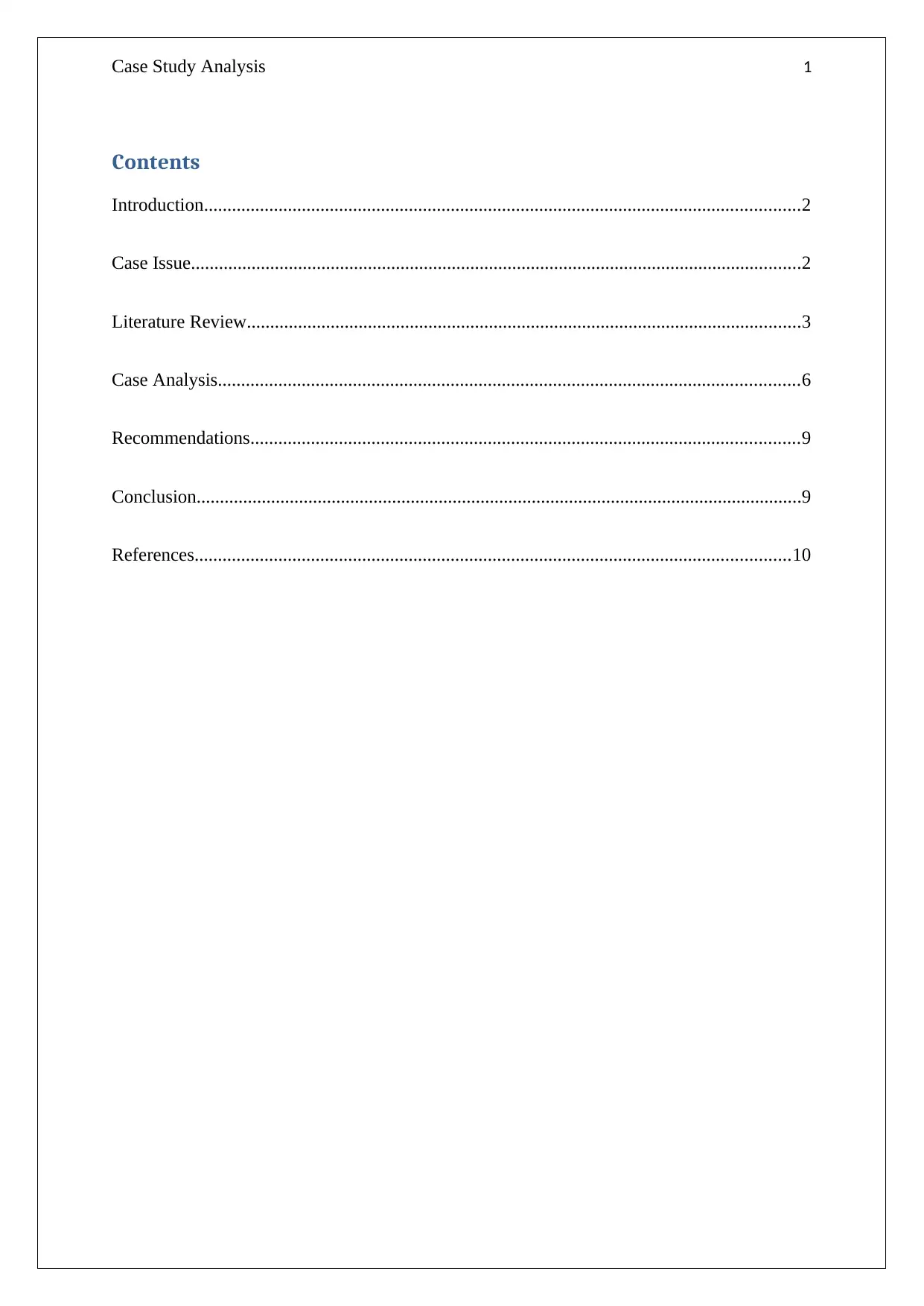
Case Study Analysis 1
Contents
Introduction................................................................................................................................2
Case Issue...................................................................................................................................2
Literature Review.......................................................................................................................3
Case Analysis.............................................................................................................................6
Recommendations......................................................................................................................9
Conclusion..................................................................................................................................9
References................................................................................................................................10
Contents
Introduction................................................................................................................................2
Case Issue...................................................................................................................................2
Literature Review.......................................................................................................................3
Case Analysis.............................................................................................................................6
Recommendations......................................................................................................................9
Conclusion..................................................................................................................................9
References................................................................................................................................10
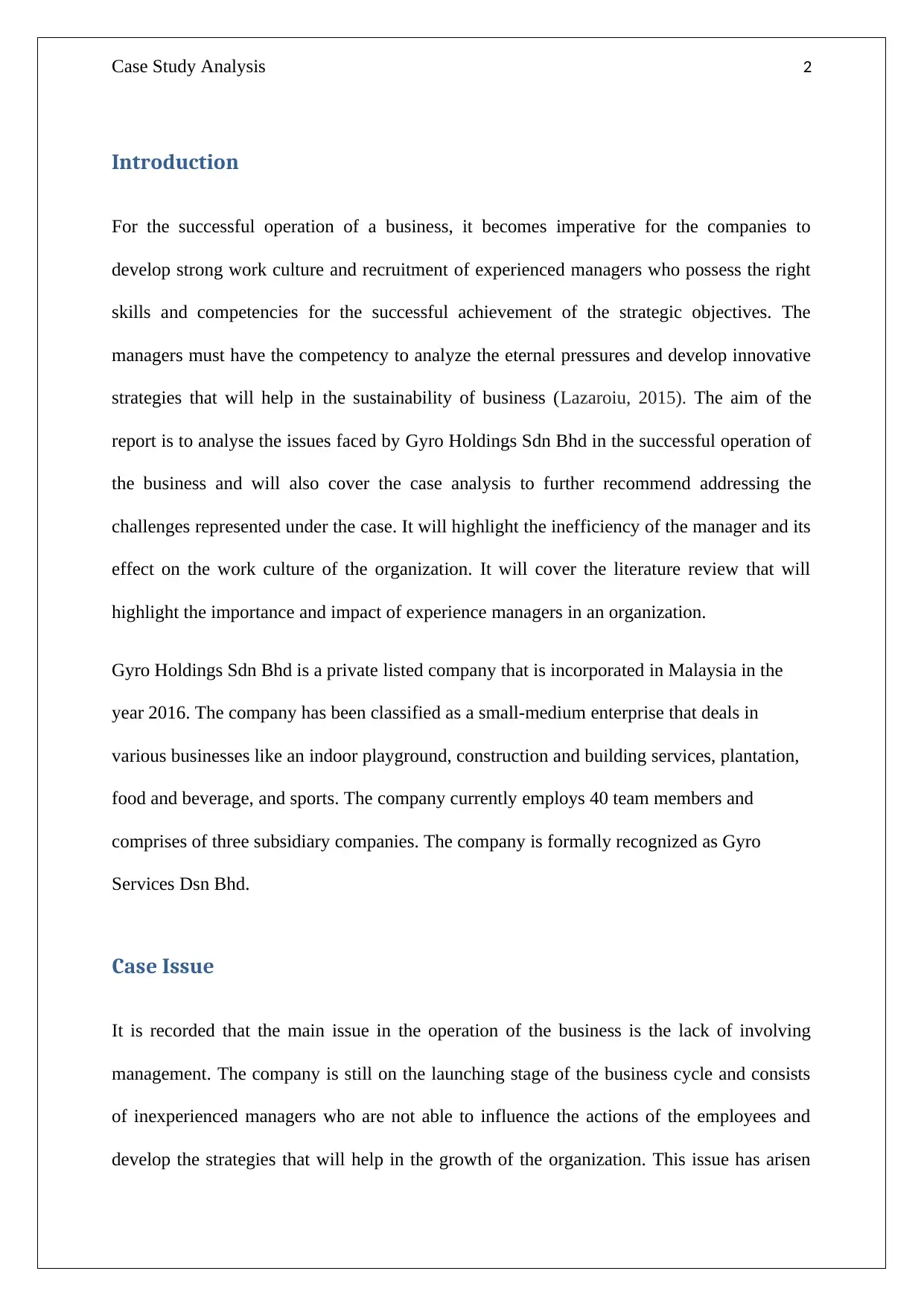
Case Study Analysis 2
Introduction
For the successful operation of a business, it becomes imperative for the companies to
develop strong work culture and recruitment of experienced managers who possess the right
skills and competencies for the successful achievement of the strategic objectives. The
managers must have the competency to analyze the eternal pressures and develop innovative
strategies that will help in the sustainability of business (Lazaroiu, 2015). The aim of the
report is to analyse the issues faced by Gyro Holdings Sdn Bhd in the successful operation of
the business and will also cover the case analysis to further recommend addressing the
challenges represented under the case. It will highlight the inefficiency of the manager and its
effect on the work culture of the organization. It will cover the literature review that will
highlight the importance and impact of experience managers in an organization.
Gyro Holdings Sdn Bhd is a private listed company that is incorporated in Malaysia in the
year 2016. The company has been classified as a small-medium enterprise that deals in
various businesses like an indoor playground, construction and building services, plantation,
food and beverage, and sports. The company currently employs 40 team members and
comprises of three subsidiary companies. The company is formally recognized as Gyro
Services Dsn Bhd.
Case Issue
It is recorded that the main issue in the operation of the business is the lack of involving
management. The company is still on the launching stage of the business cycle and consists
of inexperienced managers who are not able to influence the actions of the employees and
develop the strategies that will help in the growth of the organization. This issue has arisen
Introduction
For the successful operation of a business, it becomes imperative for the companies to
develop strong work culture and recruitment of experienced managers who possess the right
skills and competencies for the successful achievement of the strategic objectives. The
managers must have the competency to analyze the eternal pressures and develop innovative
strategies that will help in the sustainability of business (Lazaroiu, 2015). The aim of the
report is to analyse the issues faced by Gyro Holdings Sdn Bhd in the successful operation of
the business and will also cover the case analysis to further recommend addressing the
challenges represented under the case. It will highlight the inefficiency of the manager and its
effect on the work culture of the organization. It will cover the literature review that will
highlight the importance and impact of experience managers in an organization.
Gyro Holdings Sdn Bhd is a private listed company that is incorporated in Malaysia in the
year 2016. The company has been classified as a small-medium enterprise that deals in
various businesses like an indoor playground, construction and building services, plantation,
food and beverage, and sports. The company currently employs 40 team members and
comprises of three subsidiary companies. The company is formally recognized as Gyro
Services Dsn Bhd.
Case Issue
It is recorded that the main issue in the operation of the business is the lack of involving
management. The company is still on the launching stage of the business cycle and consists
of inexperienced managers who are not able to influence the actions of the employees and
develop the strategies that will help in the growth of the organization. This issue has arisen
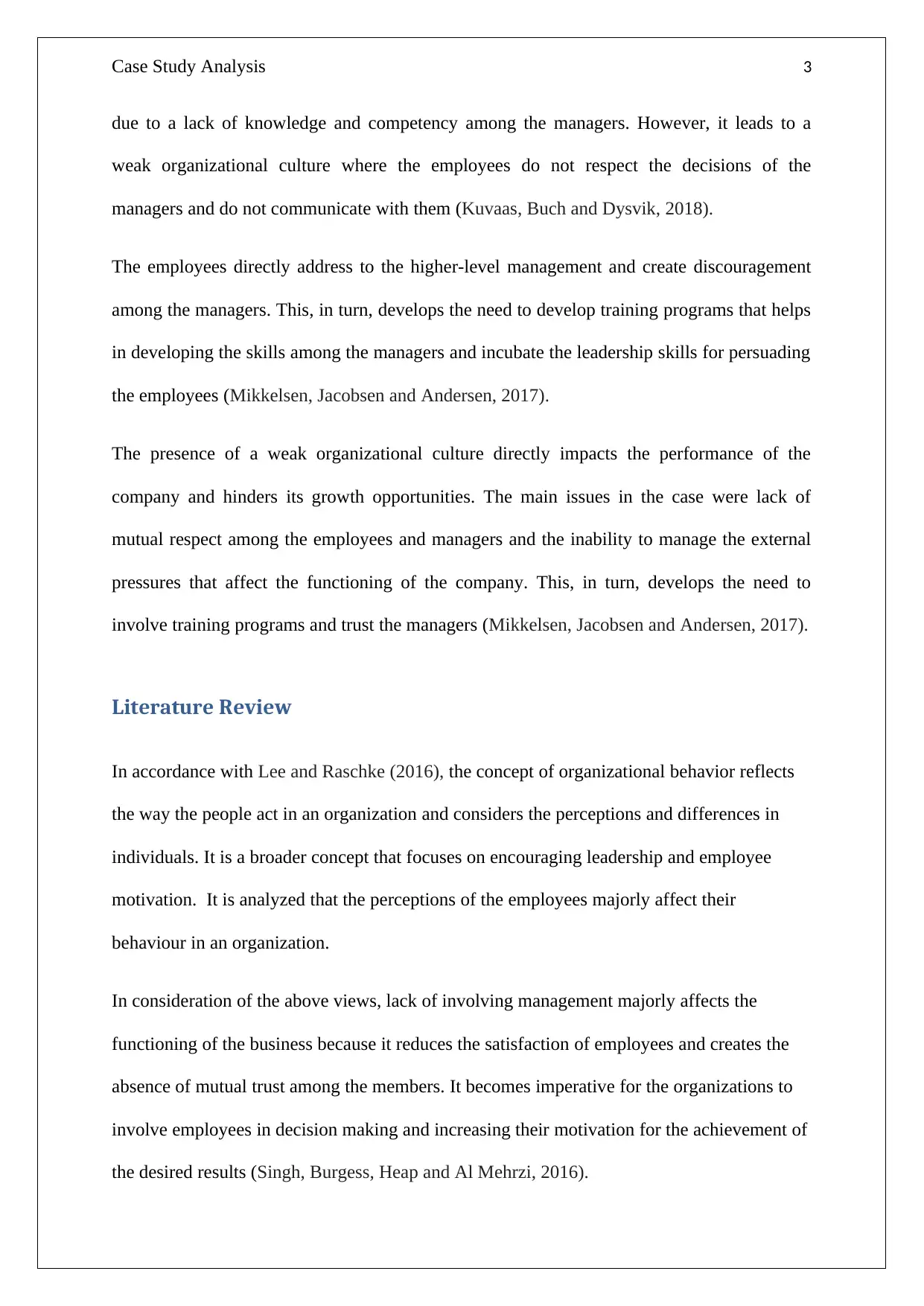
Case Study Analysis 3
due to a lack of knowledge and competency among the managers. However, it leads to a
weak organizational culture where the employees do not respect the decisions of the
managers and do not communicate with them (Kuvaas, Buch and Dysvik, 2018).
The employees directly address to the higher-level management and create discouragement
among the managers. This, in turn, develops the need to develop training programs that helps
in developing the skills among the managers and incubate the leadership skills for persuading
the employees (Mikkelsen, Jacobsen and Andersen, 2017).
The presence of a weak organizational culture directly impacts the performance of the
company and hinders its growth opportunities. The main issues in the case were lack of
mutual respect among the employees and managers and the inability to manage the external
pressures that affect the functioning of the company. This, in turn, develops the need to
involve training programs and trust the managers (Mikkelsen, Jacobsen and Andersen, 2017).
Literature Review
In accordance with Lee and Raschke (2016), the concept of organizational behavior reflects
the way the people act in an organization and considers the perceptions and differences in
individuals. It is a broader concept that focuses on encouraging leadership and employee
motivation. It is analyzed that the perceptions of the employees majorly affect their
behaviour in an organization.
In consideration of the above views, lack of involving management majorly affects the
functioning of the business because it reduces the satisfaction of employees and creates the
absence of mutual trust among the members. It becomes imperative for the organizations to
involve employees in decision making and increasing their motivation for the achievement of
the desired results (Singh, Burgess, Heap and Al Mehrzi, 2016).
due to a lack of knowledge and competency among the managers. However, it leads to a
weak organizational culture where the employees do not respect the decisions of the
managers and do not communicate with them (Kuvaas, Buch and Dysvik, 2018).
The employees directly address to the higher-level management and create discouragement
among the managers. This, in turn, develops the need to develop training programs that helps
in developing the skills among the managers and incubate the leadership skills for persuading
the employees (Mikkelsen, Jacobsen and Andersen, 2017).
The presence of a weak organizational culture directly impacts the performance of the
company and hinders its growth opportunities. The main issues in the case were lack of
mutual respect among the employees and managers and the inability to manage the external
pressures that affect the functioning of the company. This, in turn, develops the need to
involve training programs and trust the managers (Mikkelsen, Jacobsen and Andersen, 2017).
Literature Review
In accordance with Lee and Raschke (2016), the concept of organizational behavior reflects
the way the people act in an organization and considers the perceptions and differences in
individuals. It is a broader concept that focuses on encouraging leadership and employee
motivation. It is analyzed that the perceptions of the employees majorly affect their
behaviour in an organization.
In consideration of the above views, lack of involving management majorly affects the
functioning of the business because it reduces the satisfaction of employees and creates the
absence of mutual trust among the members. It becomes imperative for the organizations to
involve employees in decision making and increasing their motivation for the achievement of
the desired results (Singh, Burgess, Heap and Al Mehrzi, 2016).
Secure Best Marks with AI Grader
Need help grading? Try our AI Grader for instant feedback on your assignments.
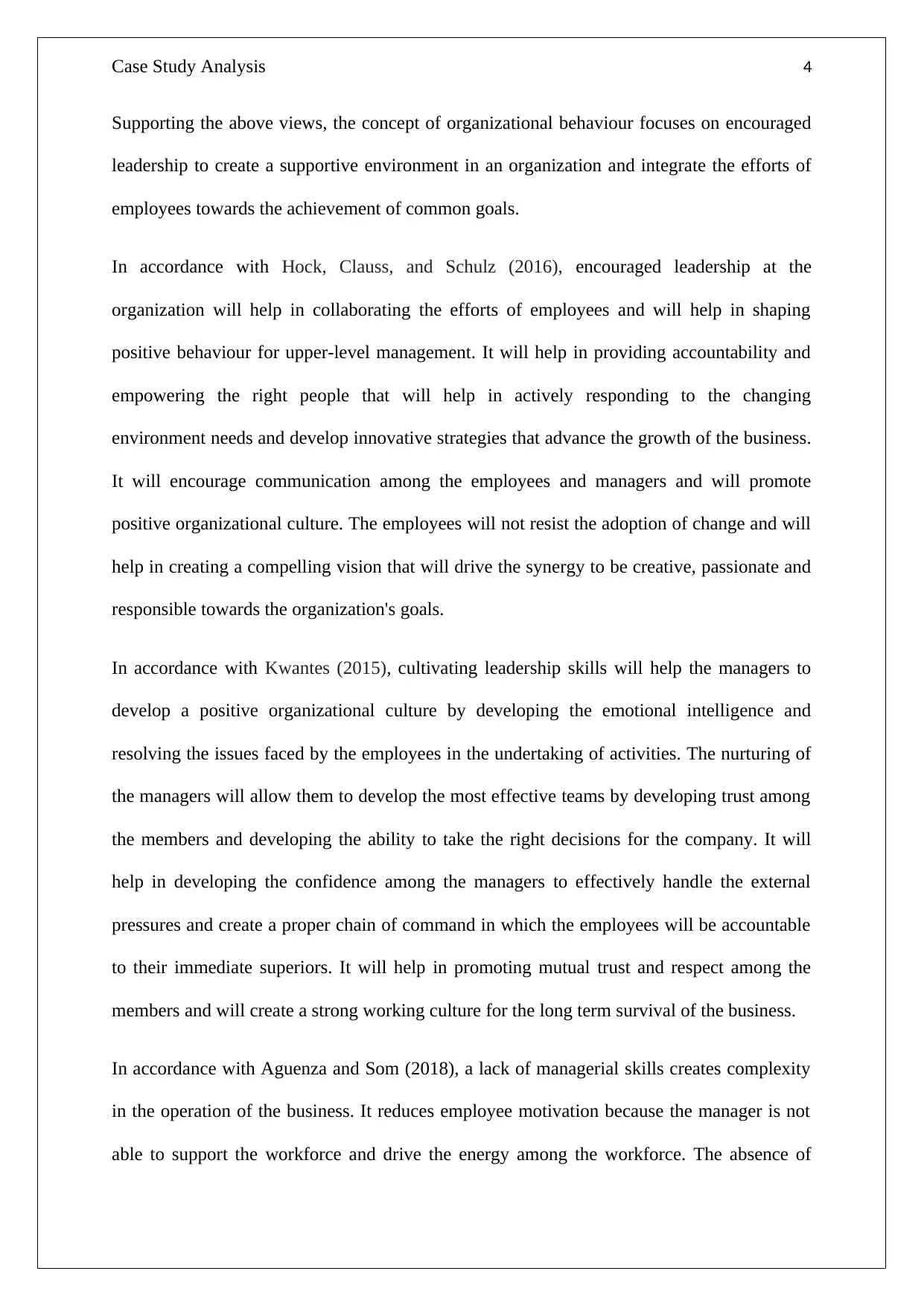
Case Study Analysis 4
Supporting the above views, the concept of organizational behaviour focuses on encouraged
leadership to create a supportive environment in an organization and integrate the efforts of
employees towards the achievement of common goals.
In accordance with Hock, Clauss, and Schulz (2016), encouraged leadership at the
organization will help in collaborating the efforts of employees and will help in shaping
positive behaviour for upper-level management. It will help in providing accountability and
empowering the right people that will help in actively responding to the changing
environment needs and develop innovative strategies that advance the growth of the business.
It will encourage communication among the employees and managers and will promote
positive organizational culture. The employees will not resist the adoption of change and will
help in creating a compelling vision that will drive the synergy to be creative, passionate and
responsible towards the organization's goals.
In accordance with Kwantes (2015), cultivating leadership skills will help the managers to
develop a positive organizational culture by developing the emotional intelligence and
resolving the issues faced by the employees in the undertaking of activities. The nurturing of
the managers will allow them to develop the most effective teams by developing trust among
the members and developing the ability to take the right decisions for the company. It will
help in developing the confidence among the managers to effectively handle the external
pressures and create a proper chain of command in which the employees will be accountable
to their immediate superiors. It will help in promoting mutual trust and respect among the
members and will create a strong working culture for the long term survival of the business.
In accordance with Aguenza and Som (2018), a lack of managerial skills creates complexity
in the operation of the business. It reduces employee motivation because the manager is not
able to support the workforce and drive the energy among the workforce. The absence of
Supporting the above views, the concept of organizational behaviour focuses on encouraged
leadership to create a supportive environment in an organization and integrate the efforts of
employees towards the achievement of common goals.
In accordance with Hock, Clauss, and Schulz (2016), encouraged leadership at the
organization will help in collaborating the efforts of employees and will help in shaping
positive behaviour for upper-level management. It will help in providing accountability and
empowering the right people that will help in actively responding to the changing
environment needs and develop innovative strategies that advance the growth of the business.
It will encourage communication among the employees and managers and will promote
positive organizational culture. The employees will not resist the adoption of change and will
help in creating a compelling vision that will drive the synergy to be creative, passionate and
responsible towards the organization's goals.
In accordance with Kwantes (2015), cultivating leadership skills will help the managers to
develop a positive organizational culture by developing the emotional intelligence and
resolving the issues faced by the employees in the undertaking of activities. The nurturing of
the managers will allow them to develop the most effective teams by developing trust among
the members and developing the ability to take the right decisions for the company. It will
help in developing the confidence among the managers to effectively handle the external
pressures and create a proper chain of command in which the employees will be accountable
to their immediate superiors. It will help in promoting mutual trust and respect among the
members and will create a strong working culture for the long term survival of the business.
In accordance with Aguenza and Som (2018), a lack of managerial skills creates complexity
in the operation of the business. It reduces employee motivation because the manager is not
able to support the workforce and drive the energy among the workforce. The absence of
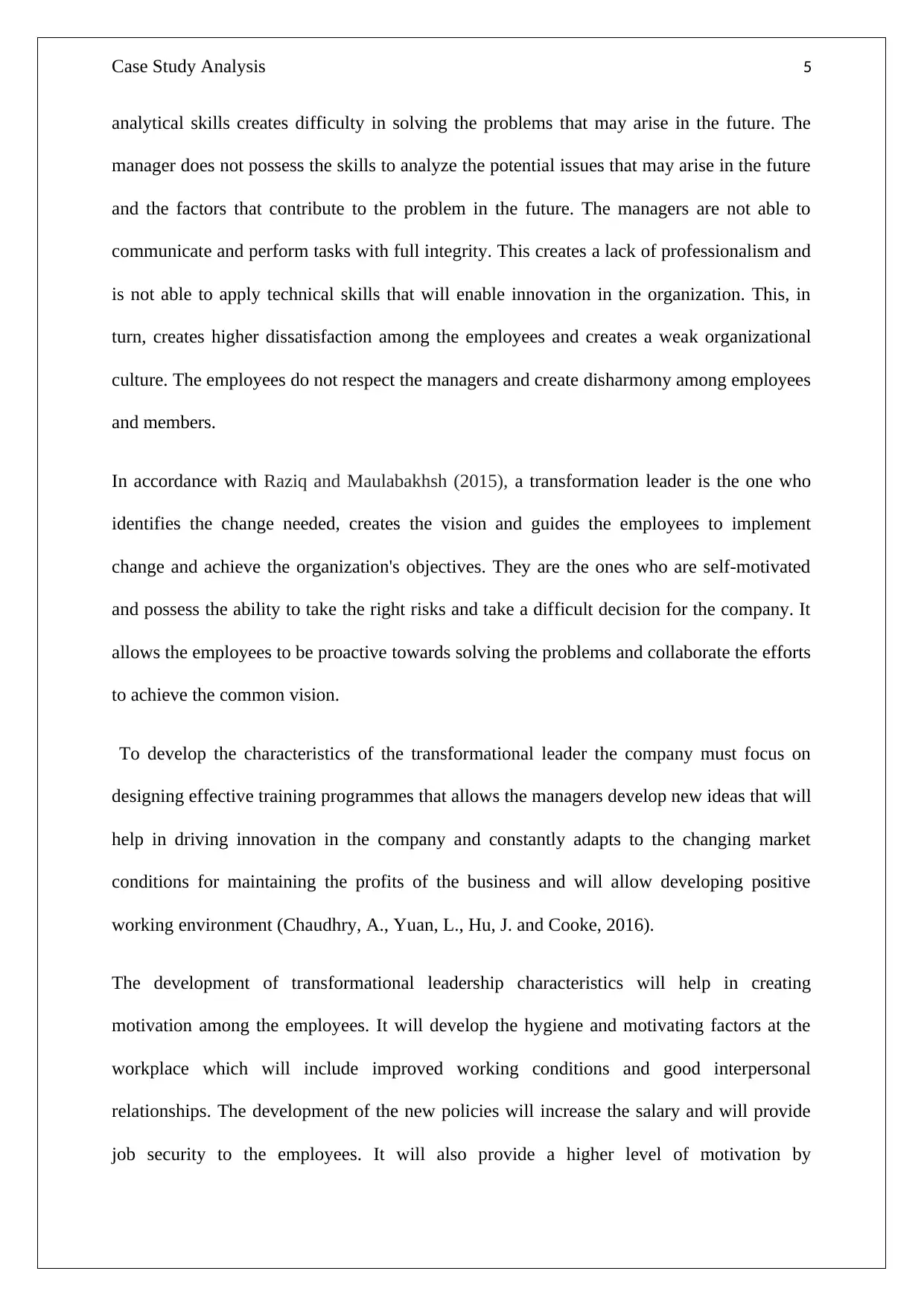
Case Study Analysis 5
analytical skills creates difficulty in solving the problems that may arise in the future. The
manager does not possess the skills to analyze the potential issues that may arise in the future
and the factors that contribute to the problem in the future. The managers are not able to
communicate and perform tasks with full integrity. This creates a lack of professionalism and
is not able to apply technical skills that will enable innovation in the organization. This, in
turn, creates higher dissatisfaction among the employees and creates a weak organizational
culture. The employees do not respect the managers and create disharmony among employees
and members.
In accordance with Raziq and Maulabakhsh (2015), a transformation leader is the one who
identifies the change needed, creates the vision and guides the employees to implement
change and achieve the organization's objectives. They are the ones who are self-motivated
and possess the ability to take the right risks and take a difficult decision for the company. It
allows the employees to be proactive towards solving the problems and collaborate the efforts
to achieve the common vision.
To develop the characteristics of the transformational leader the company must focus on
designing effective training programmes that allows the managers develop new ideas that will
help in driving innovation in the company and constantly adapts to the changing market
conditions for maintaining the profits of the business and will allow developing positive
working environment (Chaudhry, A., Yuan, L., Hu, J. and Cooke, 2016).
The development of transformational leadership characteristics will help in creating
motivation among the employees. It will develop the hygiene and motivating factors at the
workplace which will include improved working conditions and good interpersonal
relationships. The development of the new policies will increase the salary and will provide
job security to the employees. It will also provide a higher level of motivation by
analytical skills creates difficulty in solving the problems that may arise in the future. The
manager does not possess the skills to analyze the potential issues that may arise in the future
and the factors that contribute to the problem in the future. The managers are not able to
communicate and perform tasks with full integrity. This creates a lack of professionalism and
is not able to apply technical skills that will enable innovation in the organization. This, in
turn, creates higher dissatisfaction among the employees and creates a weak organizational
culture. The employees do not respect the managers and create disharmony among employees
and members.
In accordance with Raziq and Maulabakhsh (2015), a transformation leader is the one who
identifies the change needed, creates the vision and guides the employees to implement
change and achieve the organization's objectives. They are the ones who are self-motivated
and possess the ability to take the right risks and take a difficult decision for the company. It
allows the employees to be proactive towards solving the problems and collaborate the efforts
to achieve the common vision.
To develop the characteristics of the transformational leader the company must focus on
designing effective training programmes that allows the managers develop new ideas that will
help in driving innovation in the company and constantly adapts to the changing market
conditions for maintaining the profits of the business and will allow developing positive
working environment (Chaudhry, A., Yuan, L., Hu, J. and Cooke, 2016).
The development of transformational leadership characteristics will help in creating
motivation among the employees. It will develop the hygiene and motivating factors at the
workplace which will include improved working conditions and good interpersonal
relationships. The development of the new policies will increase the salary and will provide
job security to the employees. It will also provide a higher level of motivation by
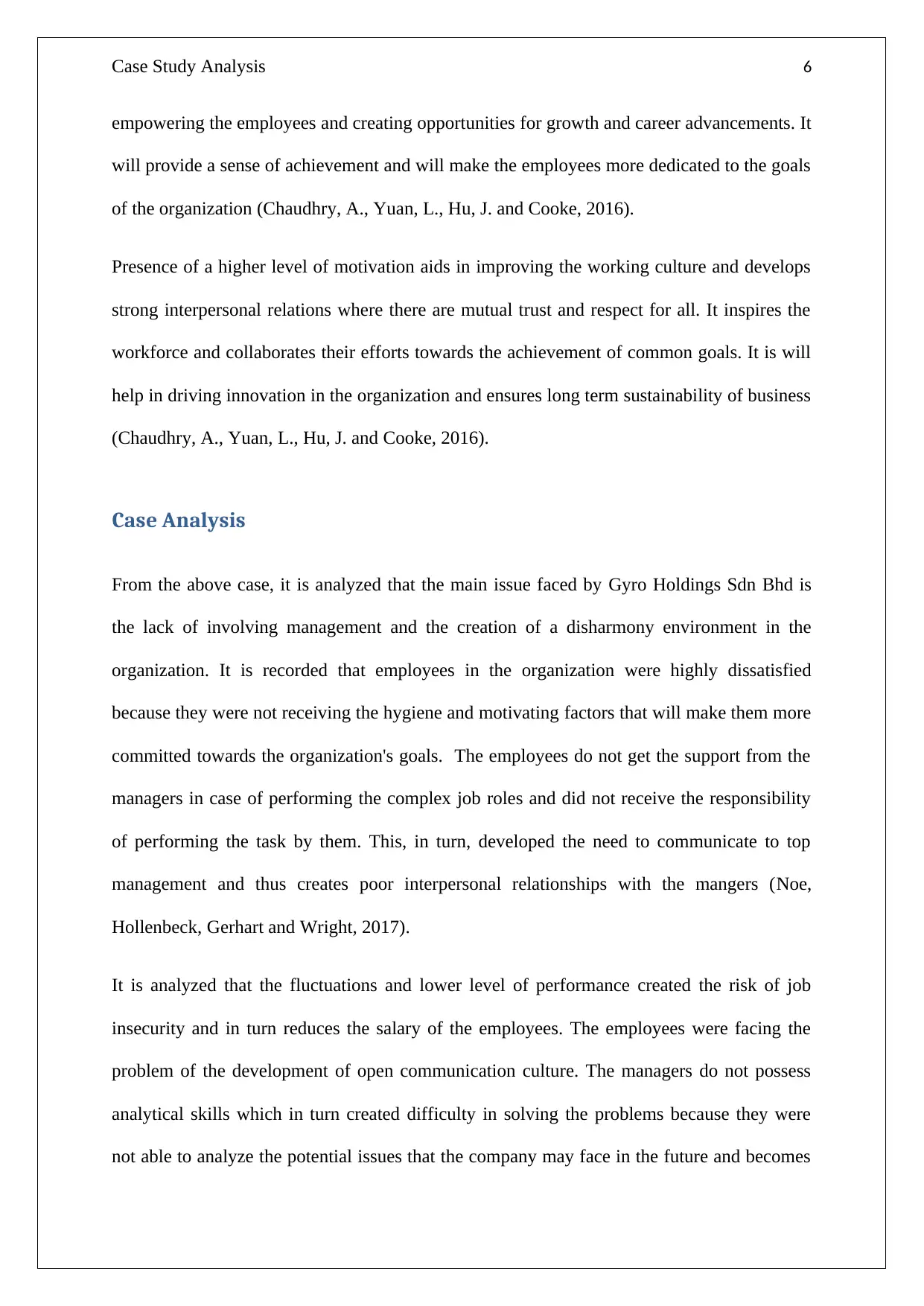
Case Study Analysis 6
empowering the employees and creating opportunities for growth and career advancements. It
will provide a sense of achievement and will make the employees more dedicated to the goals
of the organization (Chaudhry, A., Yuan, L., Hu, J. and Cooke, 2016).
Presence of a higher level of motivation aids in improving the working culture and develops
strong interpersonal relations where there are mutual trust and respect for all. It inspires the
workforce and collaborates their efforts towards the achievement of common goals. It is will
help in driving innovation in the organization and ensures long term sustainability of business
(Chaudhry, A., Yuan, L., Hu, J. and Cooke, 2016).
Case Analysis
From the above case, it is analyzed that the main issue faced by Gyro Holdings Sdn Bhd is
the lack of involving management and the creation of a disharmony environment in the
organization. It is recorded that employees in the organization were highly dissatisfied
because they were not receiving the hygiene and motivating factors that will make them more
committed towards the organization's goals. The employees do not get the support from the
managers in case of performing the complex job roles and did not receive the responsibility
of performing the task by them. This, in turn, developed the need to communicate to top
management and thus creates poor interpersonal relationships with the mangers (Noe,
Hollenbeck, Gerhart and Wright, 2017).
It is analyzed that the fluctuations and lower level of performance created the risk of job
insecurity and in turn reduces the salary of the employees. The employees were facing the
problem of the development of open communication culture. The managers do not possess
analytical skills which in turn created difficulty in solving the problems because they were
not able to analyze the potential issues that the company may face in the future and becomes
empowering the employees and creating opportunities for growth and career advancements. It
will provide a sense of achievement and will make the employees more dedicated to the goals
of the organization (Chaudhry, A., Yuan, L., Hu, J. and Cooke, 2016).
Presence of a higher level of motivation aids in improving the working culture and develops
strong interpersonal relations where there are mutual trust and respect for all. It inspires the
workforce and collaborates their efforts towards the achievement of common goals. It is will
help in driving innovation in the organization and ensures long term sustainability of business
(Chaudhry, A., Yuan, L., Hu, J. and Cooke, 2016).
Case Analysis
From the above case, it is analyzed that the main issue faced by Gyro Holdings Sdn Bhd is
the lack of involving management and the creation of a disharmony environment in the
organization. It is recorded that employees in the organization were highly dissatisfied
because they were not receiving the hygiene and motivating factors that will make them more
committed towards the organization's goals. The employees do not get the support from the
managers in case of performing the complex job roles and did not receive the responsibility
of performing the task by them. This, in turn, developed the need to communicate to top
management and thus creates poor interpersonal relationships with the mangers (Noe,
Hollenbeck, Gerhart and Wright, 2017).
It is analyzed that the fluctuations and lower level of performance created the risk of job
insecurity and in turn reduces the salary of the employees. The employees were facing the
problem of the development of open communication culture. The managers do not possess
analytical skills which in turn created difficulty in solving the problems because they were
not able to analyze the potential issues that the company may face in the future and becomes
Paraphrase This Document
Need a fresh take? Get an instant paraphrase of this document with our AI Paraphraser
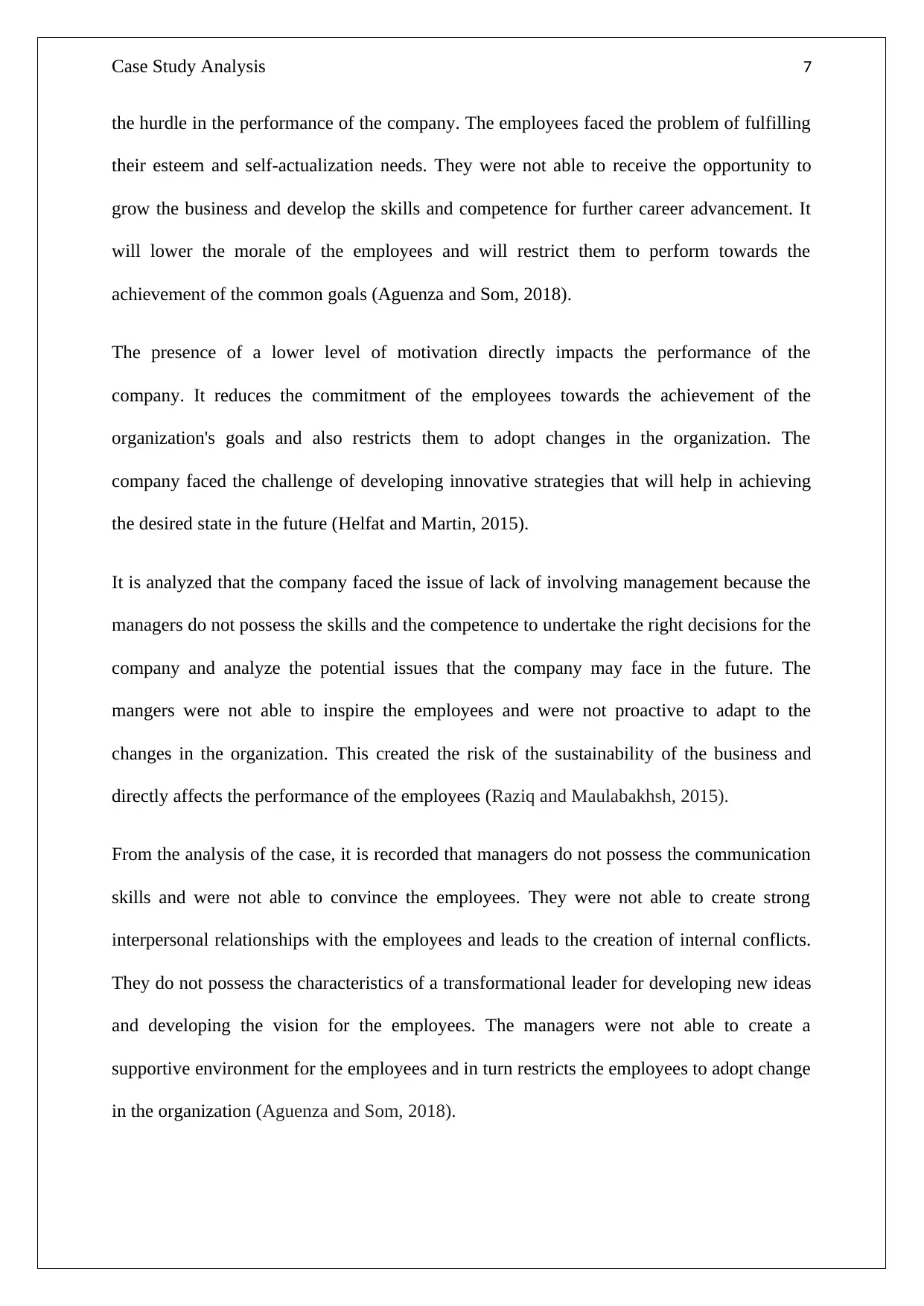
Case Study Analysis 7
the hurdle in the performance of the company. The employees faced the problem of fulfilling
their esteem and self-actualization needs. They were not able to receive the opportunity to
grow the business and develop the skills and competence for further career advancement. It
will lower the morale of the employees and will restrict them to perform towards the
achievement of the common goals (Aguenza and Som, 2018).
The presence of a lower level of motivation directly impacts the performance of the
company. It reduces the commitment of the employees towards the achievement of the
organization's goals and also restricts them to adopt changes in the organization. The
company faced the challenge of developing innovative strategies that will help in achieving
the desired state in the future (Helfat and Martin, 2015).
It is analyzed that the company faced the issue of lack of involving management because the
managers do not possess the skills and the competence to undertake the right decisions for the
company and analyze the potential issues that the company may face in the future. The
mangers were not able to inspire the employees and were not proactive to adapt to the
changes in the organization. This created the risk of the sustainability of the business and
directly affects the performance of the employees (Raziq and Maulabakhsh, 2015).
From the analysis of the case, it is recorded that managers do not possess the communication
skills and were not able to convince the employees. They were not able to create strong
interpersonal relationships with the employees and leads to the creation of internal conflicts.
They do not possess the characteristics of a transformational leader for developing new ideas
and developing the vision for the employees. The managers were not able to create a
supportive environment for the employees and in turn restricts the employees to adopt change
in the organization (Aguenza and Som, 2018).
the hurdle in the performance of the company. The employees faced the problem of fulfilling
their esteem and self-actualization needs. They were not able to receive the opportunity to
grow the business and develop the skills and competence for further career advancement. It
will lower the morale of the employees and will restrict them to perform towards the
achievement of the common goals (Aguenza and Som, 2018).
The presence of a lower level of motivation directly impacts the performance of the
company. It reduces the commitment of the employees towards the achievement of the
organization's goals and also restricts them to adopt changes in the organization. The
company faced the challenge of developing innovative strategies that will help in achieving
the desired state in the future (Helfat and Martin, 2015).
It is analyzed that the company faced the issue of lack of involving management because the
managers do not possess the skills and the competence to undertake the right decisions for the
company and analyze the potential issues that the company may face in the future. The
mangers were not able to inspire the employees and were not proactive to adapt to the
changes in the organization. This created the risk of the sustainability of the business and
directly affects the performance of the employees (Raziq and Maulabakhsh, 2015).
From the analysis of the case, it is recorded that managers do not possess the communication
skills and were not able to convince the employees. They were not able to create strong
interpersonal relationships with the employees and leads to the creation of internal conflicts.
They do not possess the characteristics of a transformational leader for developing new ideas
and developing the vision for the employees. The managers were not able to create a
supportive environment for the employees and in turn restricts the employees to adopt change
in the organization (Aguenza and Som, 2018).
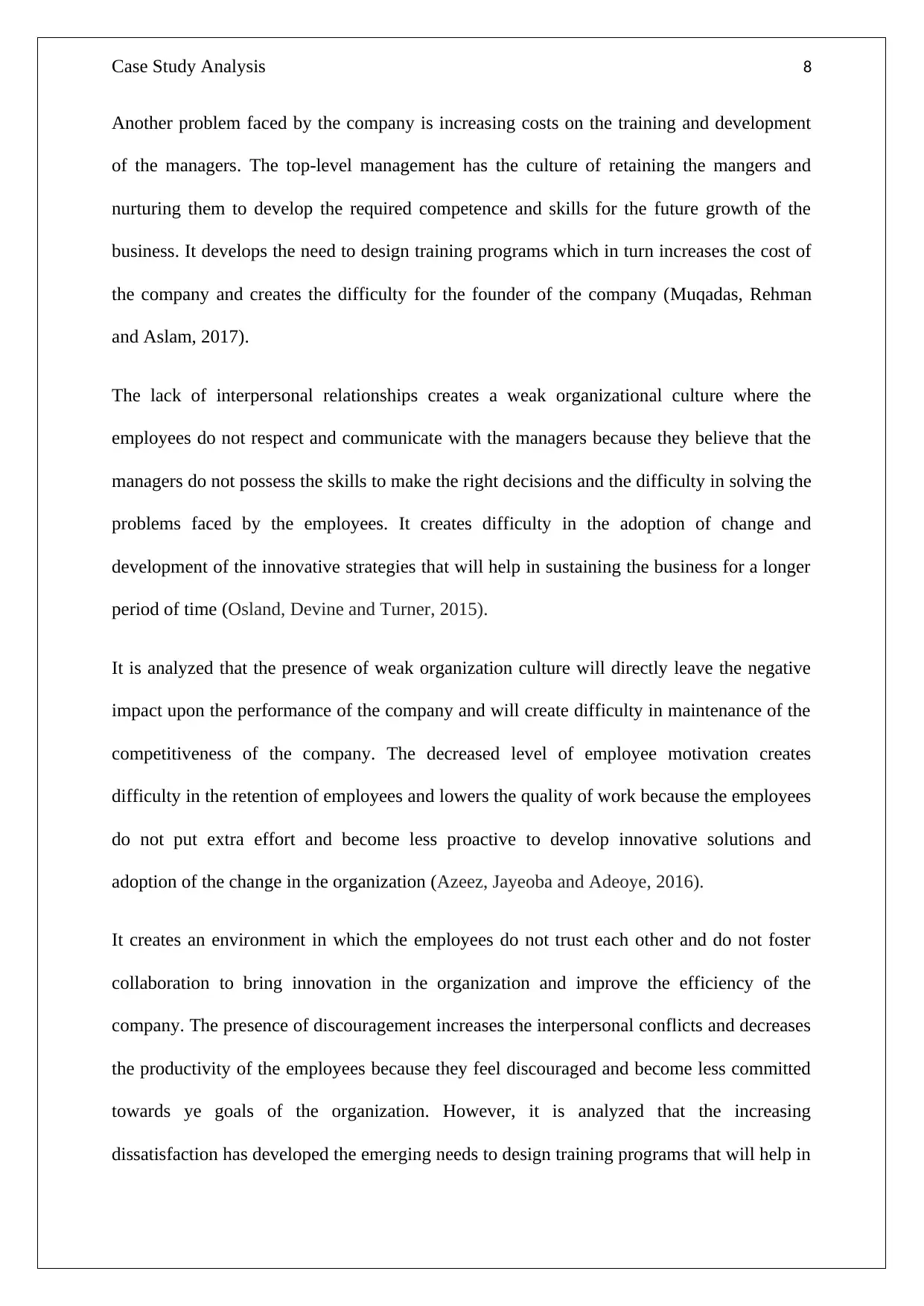
Case Study Analysis 8
Another problem faced by the company is increasing costs on the training and development
of the managers. The top-level management has the culture of retaining the mangers and
nurturing them to develop the required competence and skills for the future growth of the
business. It develops the need to design training programs which in turn increases the cost of
the company and creates the difficulty for the founder of the company (Muqadas, Rehman
and Aslam, 2017).
The lack of interpersonal relationships creates a weak organizational culture where the
employees do not respect and communicate with the managers because they believe that the
managers do not possess the skills to make the right decisions and the difficulty in solving the
problems faced by the employees. It creates difficulty in the adoption of change and
development of the innovative strategies that will help in sustaining the business for a longer
period of time (Osland, Devine and Turner, 2015).
It is analyzed that the presence of weak organization culture will directly leave the negative
impact upon the performance of the company and will create difficulty in maintenance of the
competitiveness of the company. The decreased level of employee motivation creates
difficulty in the retention of employees and lowers the quality of work because the employees
do not put extra effort and become less proactive to develop innovative solutions and
adoption of the change in the organization (Azeez, Jayeoba and Adeoye, 2016).
It creates an environment in which the employees do not trust each other and do not foster
collaboration to bring innovation in the organization and improve the efficiency of the
company. The presence of discouragement increases the interpersonal conflicts and decreases
the productivity of the employees because they feel discouraged and become less committed
towards ye goals of the organization. However, it is analyzed that the increasing
dissatisfaction has developed the emerging needs to design training programs that will help in
Another problem faced by the company is increasing costs on the training and development
of the managers. The top-level management has the culture of retaining the mangers and
nurturing them to develop the required competence and skills for the future growth of the
business. It develops the need to design training programs which in turn increases the cost of
the company and creates the difficulty for the founder of the company (Muqadas, Rehman
and Aslam, 2017).
The lack of interpersonal relationships creates a weak organizational culture where the
employees do not respect and communicate with the managers because they believe that the
managers do not possess the skills to make the right decisions and the difficulty in solving the
problems faced by the employees. It creates difficulty in the adoption of change and
development of the innovative strategies that will help in sustaining the business for a longer
period of time (Osland, Devine and Turner, 2015).
It is analyzed that the presence of weak organization culture will directly leave the negative
impact upon the performance of the company and will create difficulty in maintenance of the
competitiveness of the company. The decreased level of employee motivation creates
difficulty in the retention of employees and lowers the quality of work because the employees
do not put extra effort and become less proactive to develop innovative solutions and
adoption of the change in the organization (Azeez, Jayeoba and Adeoye, 2016).
It creates an environment in which the employees do not trust each other and do not foster
collaboration to bring innovation in the organization and improve the efficiency of the
company. The presence of discouragement increases the interpersonal conflicts and decreases
the productivity of the employees because they feel discouraged and become less committed
towards ye goals of the organization. However, it is analyzed that the increasing
dissatisfaction has developed the emerging needs to design training programs that will help in
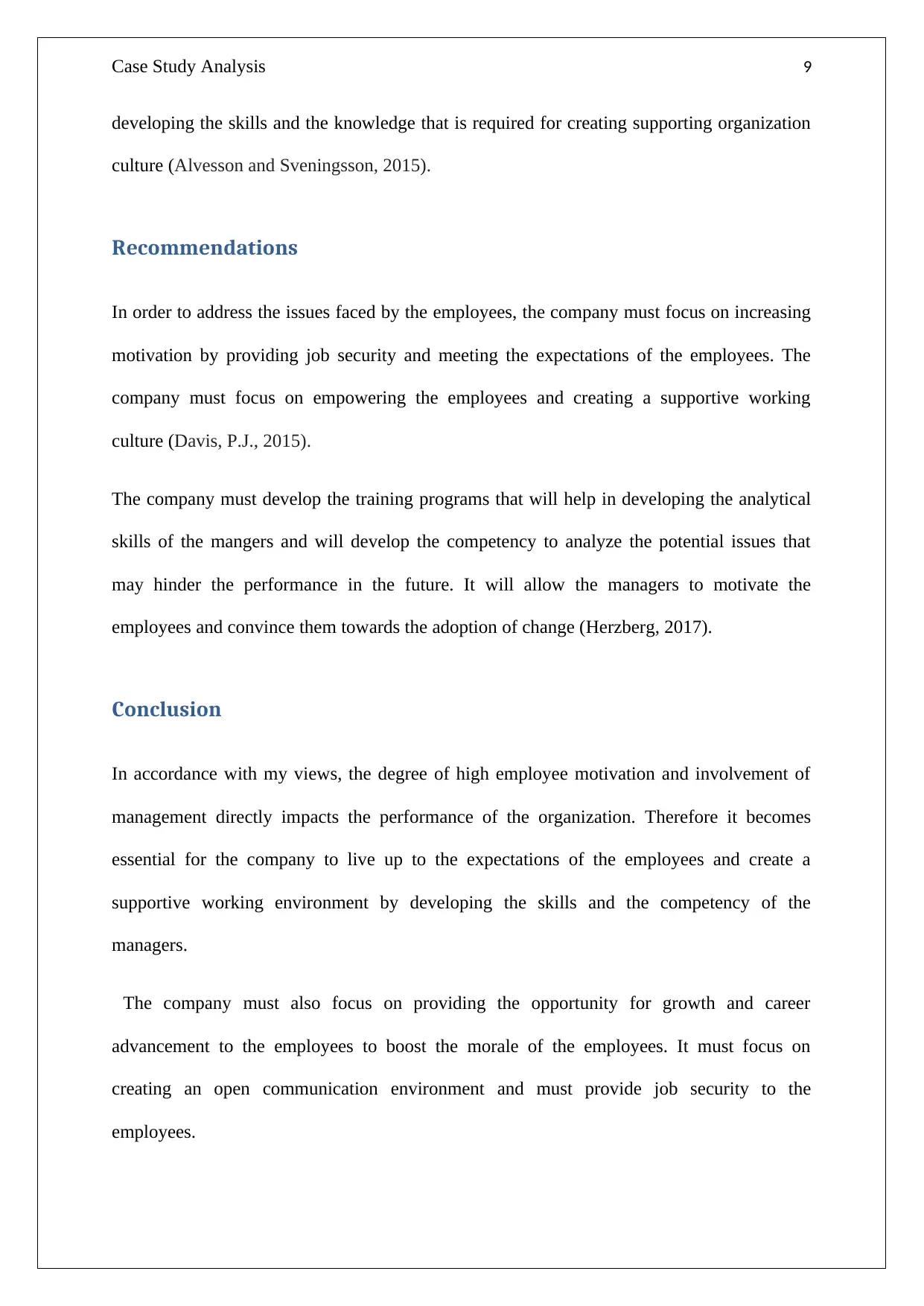
Case Study Analysis 9
developing the skills and the knowledge that is required for creating supporting organization
culture (Alvesson and Sveningsson, 2015).
Recommendations
In order to address the issues faced by the employees, the company must focus on increasing
motivation by providing job security and meeting the expectations of the employees. The
company must focus on empowering the employees and creating a supportive working
culture (Davis, P.J., 2015).
The company must develop the training programs that will help in developing the analytical
skills of the mangers and will develop the competency to analyze the potential issues that
may hinder the performance in the future. It will allow the managers to motivate the
employees and convince them towards the adoption of change (Herzberg, 2017).
Conclusion
In accordance with my views, the degree of high employee motivation and involvement of
management directly impacts the performance of the organization. Therefore it becomes
essential for the company to live up to the expectations of the employees and create a
supportive working environment by developing the skills and the competency of the
managers.
The company must also focus on providing the opportunity for growth and career
advancement to the employees to boost the morale of the employees. It must focus on
creating an open communication environment and must provide job security to the
employees.
developing the skills and the knowledge that is required for creating supporting organization
culture (Alvesson and Sveningsson, 2015).
Recommendations
In order to address the issues faced by the employees, the company must focus on increasing
motivation by providing job security and meeting the expectations of the employees. The
company must focus on empowering the employees and creating a supportive working
culture (Davis, P.J., 2015).
The company must develop the training programs that will help in developing the analytical
skills of the mangers and will develop the competency to analyze the potential issues that
may hinder the performance in the future. It will allow the managers to motivate the
employees and convince them towards the adoption of change (Herzberg, 2017).
Conclusion
In accordance with my views, the degree of high employee motivation and involvement of
management directly impacts the performance of the organization. Therefore it becomes
essential for the company to live up to the expectations of the employees and create a
supportive working environment by developing the skills and the competency of the
managers.
The company must also focus on providing the opportunity for growth and career
advancement to the employees to boost the morale of the employees. It must focus on
creating an open communication environment and must provide job security to the
employees.
Secure Best Marks with AI Grader
Need help grading? Try our AI Grader for instant feedback on your assignments.
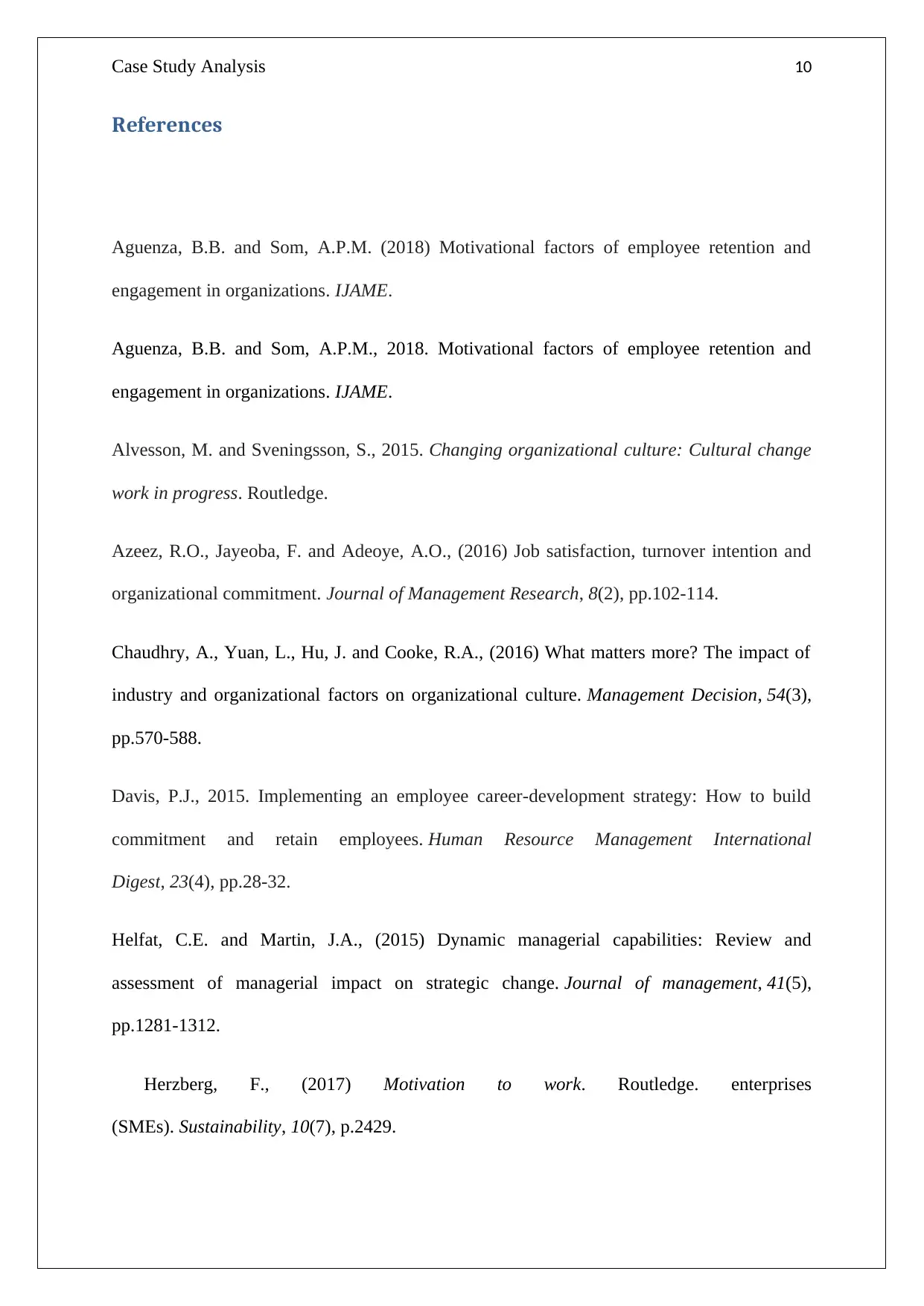
Case Study Analysis 10
References
Aguenza, B.B. and Som, A.P.M. (2018) Motivational factors of employee retention and
engagement in organizations. IJAME.
Aguenza, B.B. and Som, A.P.M., 2018. Motivational factors of employee retention and
engagement in organizations. IJAME.
Alvesson, M. and Sveningsson, S., 2015. Changing organizational culture: Cultural change
work in progress. Routledge.
Azeez, R.O., Jayeoba, F. and Adeoye, A.O., (2016) Job satisfaction, turnover intention and
organizational commitment. Journal of Management Research, 8(2), pp.102-114.
Chaudhry, A., Yuan, L., Hu, J. and Cooke, R.A., (2016) What matters more? The impact of
industry and organizational factors on organizational culture. Management Decision, 54(3),
pp.570-588.
Davis, P.J., 2015. Implementing an employee career-development strategy: How to build
commitment and retain employees. Human Resource Management International
Digest, 23(4), pp.28-32.
Helfat, C.E. and Martin, J.A., (2015) Dynamic managerial capabilities: Review and
assessment of managerial impact on strategic change. Journal of management, 41(5),
pp.1281-1312.
Herzberg, F., (2017) Motivation to work. Routledge. enterprises
(SMEs). Sustainability, 10(7), p.2429.
References
Aguenza, B.B. and Som, A.P.M. (2018) Motivational factors of employee retention and
engagement in organizations. IJAME.
Aguenza, B.B. and Som, A.P.M., 2018. Motivational factors of employee retention and
engagement in organizations. IJAME.
Alvesson, M. and Sveningsson, S., 2015. Changing organizational culture: Cultural change
work in progress. Routledge.
Azeez, R.O., Jayeoba, F. and Adeoye, A.O., (2016) Job satisfaction, turnover intention and
organizational commitment. Journal of Management Research, 8(2), pp.102-114.
Chaudhry, A., Yuan, L., Hu, J. and Cooke, R.A., (2016) What matters more? The impact of
industry and organizational factors on organizational culture. Management Decision, 54(3),
pp.570-588.
Davis, P.J., 2015. Implementing an employee career-development strategy: How to build
commitment and retain employees. Human Resource Management International
Digest, 23(4), pp.28-32.
Helfat, C.E. and Martin, J.A., (2015) Dynamic managerial capabilities: Review and
assessment of managerial impact on strategic change. Journal of management, 41(5),
pp.1281-1312.
Herzberg, F., (2017) Motivation to work. Routledge. enterprises
(SMEs). Sustainability, 10(7), p.2429.
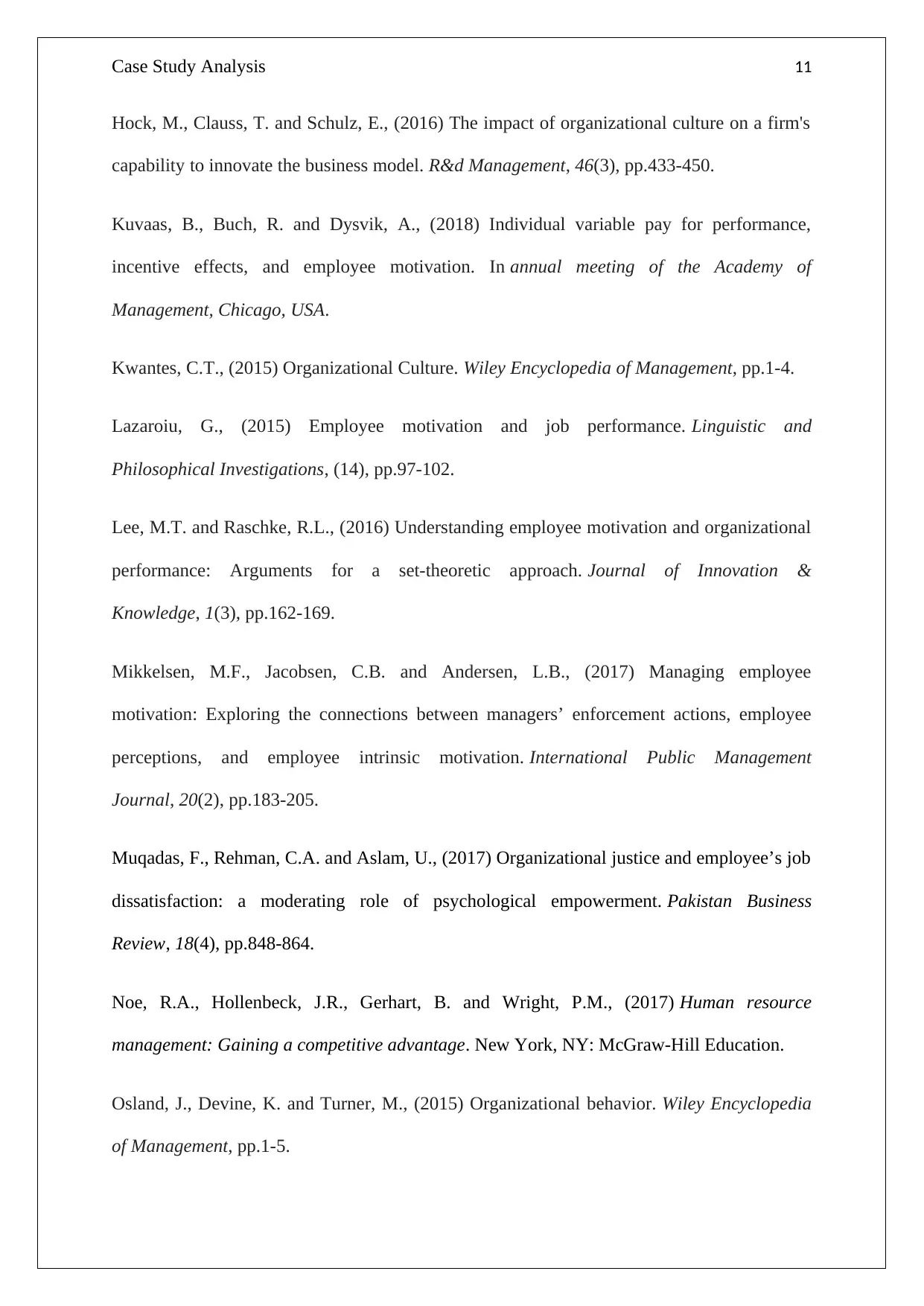
Case Study Analysis 11
Hock, M., Clauss, T. and Schulz, E., (2016) The impact of organizational culture on a firm's
capability to innovate the business model. R&d Management, 46(3), pp.433-450.
Kuvaas, B., Buch, R. and Dysvik, A., (2018) Individual variable pay for performance,
incentive effects, and employee motivation. In annual meeting of the Academy of
Management, Chicago, USA.
Kwantes, C.T., (2015) Organizational Culture. Wiley Encyclopedia of Management, pp.1-4.
Lazaroiu, G., (2015) Employee motivation and job performance. Linguistic and
Philosophical Investigations, (14), pp.97-102.
Lee, M.T. and Raschke, R.L., (2016) Understanding employee motivation and organizational
performance: Arguments for a set-theoretic approach. Journal of Innovation &
Knowledge, 1(3), pp.162-169.
Mikkelsen, M.F., Jacobsen, C.B. and Andersen, L.B., (2017) Managing employee
motivation: Exploring the connections between managers’ enforcement actions, employee
perceptions, and employee intrinsic motivation. International Public Management
Journal, 20(2), pp.183-205.
Muqadas, F., Rehman, C.A. and Aslam, U., (2017) Organizational justice and employee’s job
dissatisfaction: a moderating role of psychological empowerment. Pakistan Business
Review, 18(4), pp.848-864.
Noe, R.A., Hollenbeck, J.R., Gerhart, B. and Wright, P.M., (2017) Human resource
management: Gaining a competitive advantage. New York, NY: McGraw-Hill Education.
Osland, J., Devine, K. and Turner, M., (2015) Organizational behavior. Wiley Encyclopedia
of Management, pp.1-5.
Hock, M., Clauss, T. and Schulz, E., (2016) The impact of organizational culture on a firm's
capability to innovate the business model. R&d Management, 46(3), pp.433-450.
Kuvaas, B., Buch, R. and Dysvik, A., (2018) Individual variable pay for performance,
incentive effects, and employee motivation. In annual meeting of the Academy of
Management, Chicago, USA.
Kwantes, C.T., (2015) Organizational Culture. Wiley Encyclopedia of Management, pp.1-4.
Lazaroiu, G., (2015) Employee motivation and job performance. Linguistic and
Philosophical Investigations, (14), pp.97-102.
Lee, M.T. and Raschke, R.L., (2016) Understanding employee motivation and organizational
performance: Arguments for a set-theoretic approach. Journal of Innovation &
Knowledge, 1(3), pp.162-169.
Mikkelsen, M.F., Jacobsen, C.B. and Andersen, L.B., (2017) Managing employee
motivation: Exploring the connections between managers’ enforcement actions, employee
perceptions, and employee intrinsic motivation. International Public Management
Journal, 20(2), pp.183-205.
Muqadas, F., Rehman, C.A. and Aslam, U., (2017) Organizational justice and employee’s job
dissatisfaction: a moderating role of psychological empowerment. Pakistan Business
Review, 18(4), pp.848-864.
Noe, R.A., Hollenbeck, J.R., Gerhart, B. and Wright, P.M., (2017) Human resource
management: Gaining a competitive advantage. New York, NY: McGraw-Hill Education.
Osland, J., Devine, K. and Turner, M., (2015) Organizational behavior. Wiley Encyclopedia
of Management, pp.1-5.
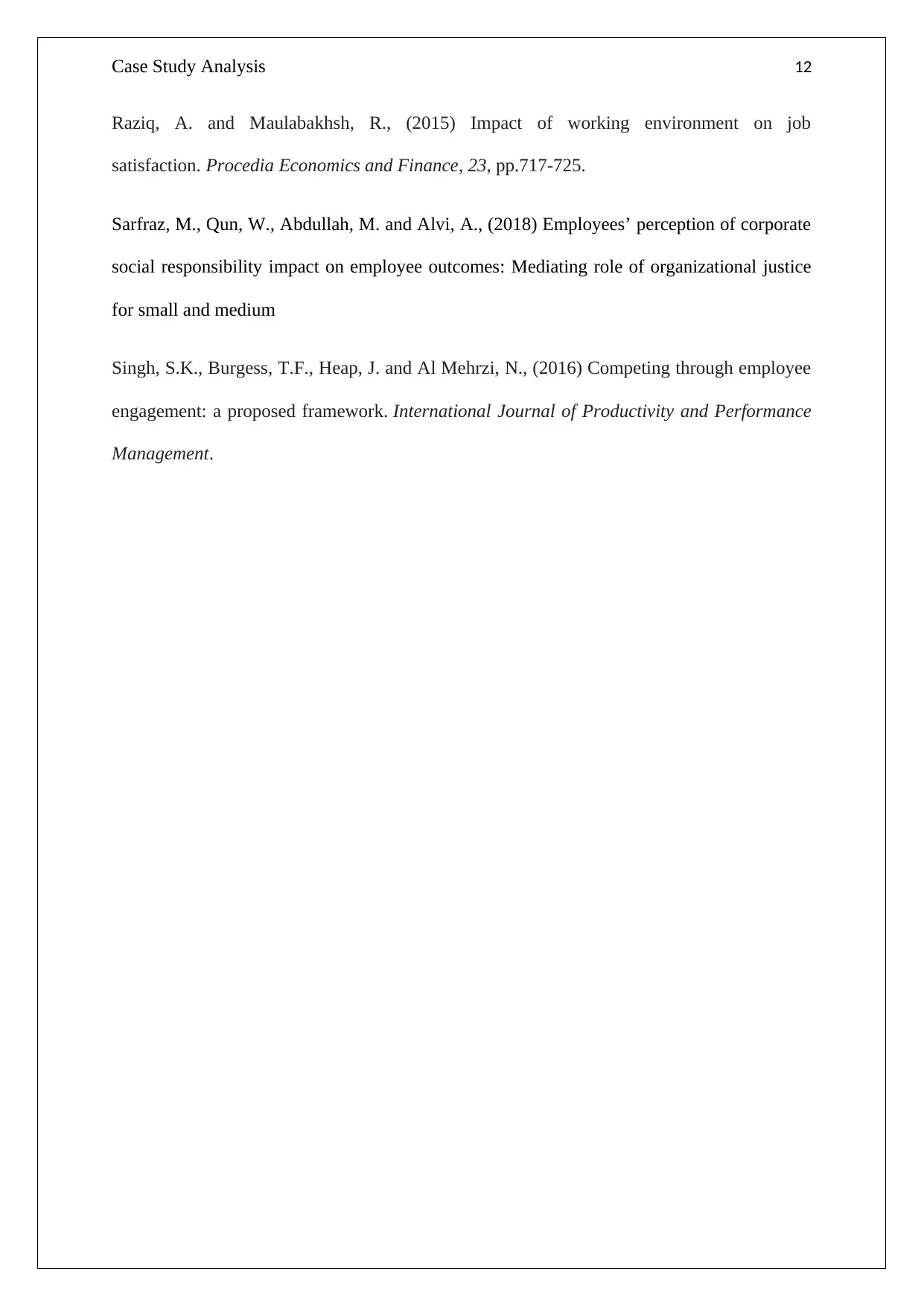
Case Study Analysis 12
Raziq, A. and Maulabakhsh, R., (2015) Impact of working environment on job
satisfaction. Procedia Economics and Finance, 23, pp.717-725.
Sarfraz, M., Qun, W., Abdullah, M. and Alvi, A., (2018) Employees’ perception of corporate
social responsibility impact on employee outcomes: Mediating role of organizational justice
for small and medium
Singh, S.K., Burgess, T.F., Heap, J. and Al Mehrzi, N., (2016) Competing through employee
engagement: a proposed framework. International Journal of Productivity and Performance
Management.
Raziq, A. and Maulabakhsh, R., (2015) Impact of working environment on job
satisfaction. Procedia Economics and Finance, 23, pp.717-725.
Sarfraz, M., Qun, W., Abdullah, M. and Alvi, A., (2018) Employees’ perception of corporate
social responsibility impact on employee outcomes: Mediating role of organizational justice
for small and medium
Singh, S.K., Burgess, T.F., Heap, J. and Al Mehrzi, N., (2016) Competing through employee
engagement: a proposed framework. International Journal of Productivity and Performance
Management.
1 out of 13
Related Documents
Your All-in-One AI-Powered Toolkit for Academic Success.
+13062052269
info@desklib.com
Available 24*7 on WhatsApp / Email
![[object Object]](/_next/static/media/star-bottom.7253800d.svg)
Unlock your academic potential
© 2024 | Zucol Services PVT LTD | All rights reserved.





